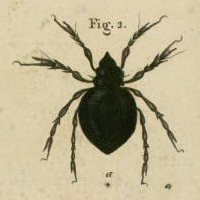Belba
| Belba | |
|---|---|

| |
| Notaspis corynopus | |
| Scientific classification | |
| Kingdom: | |
| Phylum: | |
| Class: | |
| Order: | |
| Superfamily: | Damaeoidea
|
| Family: | |
| Genus: | Belba Heyden, 1826
|
| Type species | |
| Notaspis corynopus (Hermann, 1804)
| |
Belba is a genus of mites belonging to family Damaeidae.[1] The genus was established by Carl von Heyden in 1826. Notaspis corynopus (Hermann, 1804) was the type species.[2] Species that are part of the genus can be found in Eurasia and North America.[3]
Behaviour
[edit]Members of the genus Belba are fungivores.[4] Some species have been concluded to prefer a narrow temperature range of 11 °C – 15 °C.[5]
List of species
[edit]The following species are considered to be part of the genus:[1]
- Belba aberrans
- Belba aegrota
- Belba alpina
- Belba bartosi
- Belba crassisetosa[6]
- Belba clavigera
- Belba compta
- Belba corynopus (Notaspis corynopus)
- Belba diversipilis
- Belba dubinini
- Belba gibba
- Belba globiceps
- Belba globipes
- Belba granulata
- Belba gratiosa
- Belba heterosetosa [6]
- Belba helvetica
- Belba ignota
- Belba lengensdorfi
- Belba limasetosa
- Belba longipes
- Belba longisetosa
- Belba minor
- Belba minuta
- Belba mirabilis
- Belba mongolica[6]
- Belba moraviae
- Belba obscura
- Belba pachytrichosa
- Belba paracorynopus
- Belba parvula
- Belba patelloides
- Belba piriformis
- Belba pseudocorynopus
- Belba pulchra
- Belba sculpta
- Belba sellnicki
- Belba serradeii
- Belba ursina
- Belba verrucosa
See also
[edit]References
[edit]- ^ a b "Fauna Europaea: Taxon Details". Fauna Europaea. 29 August 2013. Retrieved 20 December 2016.[dead link]
- ^ Bayartogtokh, Badamdorj (December 2000). "New oribatid mites of the genus Belba (Acari: Oribatida: Damaeidae) from Mongolia" (PDF). International Journal of Acarology. 26 (4): 297. doi:10.1080/01647950008684204. S2CID 85070964. Retrieved 20 December 2016.
- ^ Christopher Taylor (20 October 2015). "Belba (Belba)". taxondiversity.fieldofscience.com. Retrieved 20 December 2016.
- ^ Maurice W. Sabelis; Jan Bruin (16 November 2010). Trends in Acarology: Proceedings of the 12th International Congress. Springer Science & Business Media. p. 218. ISBN 978-90-481-9837-5.
- ^ David S. Madge (1965). "THE BEHAVIOUR OF BELBA GENICULOSA OUDMS. AND CERTAIN OTHER SPECIES OF ORIBATID MITES IN CONTROLLED TEMPERATURE GRADIENTS" (PDF). Acarologia. 2 (VII): 404. Retrieved 20 December 2016.
- ^ a b c Badamdorj Bayartogtokh (March 2004). "Oribatid mites of the genera Belba and Belbodamaeus (Acari: Oribatida: Damaeidae) from Eastern Mongolia" (PDF). Zootaxa. 476: 1–11. doi:10.11646/zootaxa.476.1.1. ISSN 1175-5334.
Further reading
[edit]- David S. Madge (1964). "The water relations of Belba geniculosa Oudms. and other species of oribatid mites". Acarologia. 6: 199–223.
- David S. Madge (1965). "Further studies on the behaviour of Belba geniculosa Oudms. in relation to various envinronmental stimuli". Acarologia. 7: 744–757.
- Andrey S. Zaitsev; Natalia B. Pystina (April 2014). "Remarks on fauna and population of oribatid mites (Acari: Oribatida) in Priazovsky National Wildlife Sanctuary (Southern Russia)" (PDF). Soil Organisms. 86 (1): 59–66. ISSN 1864-6417 – via Naturmuseum Senckenberg.
External links
[edit]- Belbidae at Fauna Europaea – Family of the genus Belba
- Damaeidae Species Listing in Joel Hallan's Biology Catalog by Dr. Heinrich Schatz
Text is available under the CC BY-SA 4.0 license; additional terms may apply.
Images, videos and audio are available under their respective licenses.
